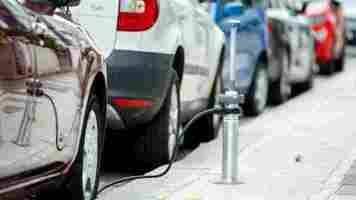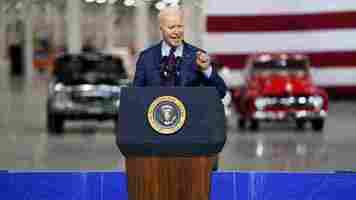London is getting slick EV chargers that vanish from sight when not in use
A first-of-its-kind EV charging system that sits flush within the pavement is being installed in London.

The “flat and flush” charge points require no permanent raised street furniture at the pavement edge, which means they don’t take up any space when not in use. The chargers then pop up when a user plugs a cable in.
Scottish startup Trojan Energy designed the tech to provide on-street charging to people who can’t charge at home. The team sought input from Disability Rights UK to ensure the system is safe for all street users.


Five of the connectors have already been installed in the London borough of Brent for an initial test of the system.
A full trial of 150 charge points across Brent and Camden will then go live from September this year to March 2022.
This system will be divided into 10 sets of 15 charge points. Each set is hooked up to a separate electricity network connection that distributes the power across the chargers.
More than 140 EV drivers and 75 prospective EV users have signed up to test the tech.
A pre-trial survey revealed that 50% of them find their current charging situation inconvenient and need a better solution. More than 70% said the availability of local charging points was an important factor for their EV purchase.
Ultimately, better access to EV chargers will play a key role in accelerating the switch from petrol to electric cars .
HT — New Atlas
You can book travel insurance for your next trip to space — wait, what?
Did you know SHIFT is taking the stage this fall ? Together with an amazing line-up of experts, we will explore the future of mobility during TNW Conference 2021. Secure your ticket now!

In the world of mobility there are two main types of insurances: motor vehicle and travel insurance.
And while, I’m sure, you all know the basics of what each of them covers, let me surprise you here by saying that travel insurance will expand to… space .
Yes, you read that correctly. Travel insurance company Battleface has launched its services for space tourists , Travel Daily News reports.
So, what does a space travel insurance cover? As per Battleface, there are many benefits included such as a ccidental death and permanent disablement .
Well, going to space is and inherently dangerous business. Say the spaceship catches fire during launch… everything goes wrong and you’re lost in space forever. But don’t worry, at least you can be insured.
Sasha Gainullin , CEO of Battleface, said:
Of course, not everyone will have the freedom to travel into space, or to be exact, the financial means.
Too expensive
Battleface’s policy is valid for any of the space flights operated by Elon Musk ’s SpaceX , Jeff Bezos ’s Blue Origin , Richard Branson’s Virgin Galactic , and high-tech balloon manufacturers, Space Perspective, among others.
A seat on SpaceX’s Crew Dragon costs the exorbitant amount of $55 million. Trips aboard the Blue Origin’s New Shepard were auctioned for $28 million. Riding on Virgin Galactic’s VSS Unity will cost passengers $250,000 apiece. And tickets for Space Perspective’s Neptune One balloon start at $125,000.
All this seems very excessive, given that we’re at least decades aways from seeing suborbital transportation and space travel becoming an integral part of mobility.
But if we really think about it, they are indeed infiltrating it.
Civilians, although not regular ones, like Musk, Branson, and Bezos have already made their first trip to space . Plus, all the companies mentioned in the insurance plans are planning commercial flights within the next three years.
So, it is kinda happening now.
Yes, commercial space travel is still in its infancy, but the fact that insurance companies are eyeing a place within this industry makes me wonder whether we’ll be alive to witness mobility moving from the earth to the stars.
Do EVs excite your electrons? Do ebikes get your wheels spinning? Do self-driving cars get you all charged up?
Then you need the weekly SHIFT newsletter in your life. Click here to sign up.
Is a $4,500 tax credit for union-built EVs unfair or proactive?
Did you know SHIFT is taking the stage this fall ? Together with an amazing line-up of experts, we will explore the future of mobility during TNW Conference 2021. Secure your ticket now!

On Friday, US Democratic lawmakers proposed a new bill increasing the current $7,500 tax creditfor electric vehicles. And while this seems like a very promising step, in reality the credit expansion favors only particular automakers.
The base amount remains unchanged at $4,000, with an extra $3,500 if the EV battery has a minimum of 40kWh — totalling the present 7,500 dollar grants.
The bill now suggests that consumers can claim an added $4,500 for vehicles assembled at a domestic unionized plant. In contrast, EVs that are American-made, but not union-built, qualify for a mere $500 extra.
To put it a nutshell, this proposal strongly favors the so-called “Big Three,” namely GM, Ford, and the Stellantis Group, whose unionized workplaces are represented by the United Auto Workers (UAW).
On the opposite side stand foreign automakers operating in the States and American Tesla as well. They don’t have unions representing their autoworkers, and in fact many of them have even battled against a unionized workplace and UAW takeovers.
For instance, workers at Volkswagen ’s assembly plant in Chattanooga, Tennessee, voted against union representation in 2019, and Nissan workers also declined to unionize in Canton, Mississippi, in 2017.
Among the affected companies, Honda and Toyota have been the first to express their opposition, Reuters reports.
Toyota said in a statement that the plan discriminates “against American autoworkers based on their choice not to unionize.”
Likewise, Honda called the bill “unfair” and stated the following:
The answer is rather complicated and there are two sides of the story.
1. The bill can be unjust.
While it would make perfect sense for the extra credit to be given to American-made EVs as a domestic economic stimulus, unionization is a sensitive and personal matter.
After all, it’s workers who decide whether to form a union — not buyers, not automakers, and certainly not the Congress.
In fact, union participation isn’t such a popular choice and numbers have been plummeting for the past two decades. In 2020, for instance, the union membership rate was at 10.8% — a 9.3% drop since 1983. This means that unionized workers make up only 1 in 10 employees.
At the same time, no one (including non-unionized workers, automakers, and consumers) should be punished because employees at an auto plant decided against forming a union.
The maximum $12,000 credit tax gives a stronger edge to EVs produced by the Big Three, which is likely to affect sales and, therefore, jobs for the other automakers.
In the case of consumers too, the bill incorporates a form of inequality. Why should someone buying a Ford EV benefit from the extra $4,500, while someone purchasing a Honda shouldn’t?
2. The bill can provide long-term benefits .
Since assuming office, Joe Biden may have been the most overtly pro-union president over the past seventy years, aiming to reverse the negative union trend.
Biden has put unions at the center of his policy, viewing them as an opportunity to rebuild middle-class jobs and to address climate change as well .
However, pushing the labor movement into the emerging green energy industry is bound to bring about controversial views.
On the one hand, unions provide a better choice for employees with benefits including higher and steady wages, stronger pension and health insurance plans, and the ability to voice concerns without the fear of retaliation.
On the other hand, expanding union membership among autoworkers would increase wages, which in turn would mean higher production costs for automakers.
Apart from the economic blow to the companies, increased production costs will also push up the cost of renewable energy, slowing down the effort to replace fossil fuels, some economists warn.
Administration officials , however, believe that the transition to green energy will be politically sustainable only if workers see jobs in the new economy delivering wages and benefits comparable with those in older, unionized sectors.
Politics aside, the latest poll by Gallup , shows now a more positive union reception than at any point in nearly two decades, with 63% of respondents saying that they approve of labor unions.
So, yes, if we examine things under this light the bill can be good in the long term, and has the potential to help the e nergy industry develop as a unionized, high-wage sector, perhaps similar to the way automobile manufacturing was in an earlier era.
On Tuesday, the House Ways and Means Committee will vote on the proposal, which is expected to face opposition in the Senate, being evenly divided 50-50 between Republicans and Democrats.
Do EVs excite your electrons? Do ebikes get your wheels spinning? Do self-driving cars get you all charged up?
Then you need the weekly SHIFT newsletter in your life. Click here to sign up.